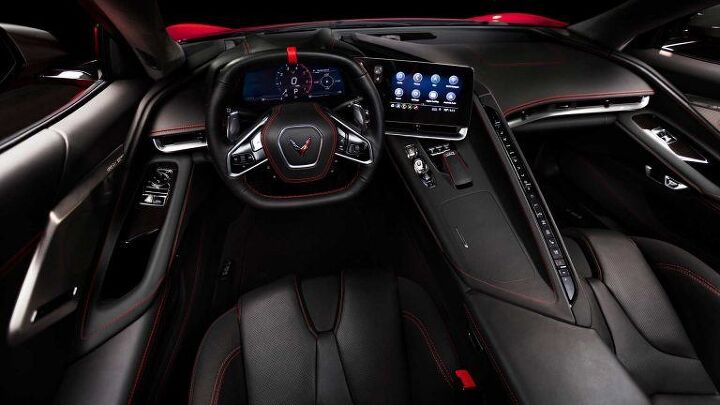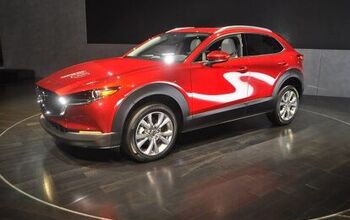2020 Corvette Stingray Pricing Revealed

When General Motors debuted the 2020 Chevrolet Corvette, the automaker promised it would start below $60,000. It’s just barely been able to keep that promise at $59,995, which incorporates the obligatory $1,095 destination charge, but it’s still an impressively low target for a mid-engined performance vehicle. You can, of course, option out Chevy’s C8 Stingray to a much higher price tag.
Fortunately, even if you go absolutely mental on the options, you’ll still be saving yourself some cash vs any of the Corvette’s chief rivals. For example, a bare-bones Porsche 911 starts at $98,750 while the Corvette has to move up two trim levels and take on loads of extras before it surpasses $80,000.
The C8 also comes equipped with a 6.2-liter V8 putting down 490 horsepower and 465 lb-ft of torque. Porsche’s 3.0-liter turbocharged flat-six only makes 379 hp and 331 lb-ft in its base configuration. By the time Chevy customers can easily outspend Porsche loyalists, GM will probably offer the C8 with a beefier engine and Z06 badge, which will no doubt undercut the 911 Turbo.
However, rather than prognosticate on how the new Stingray will continue to remain dirt cheap vs its European rivals, let’s examine what Chevrolet is actually offering. Starting with the $59,995 base 1LT model, customers receive the aforementioned 6.2-liter V8, eight-speed dual clutch automatic, LED headlamps, 8-way adjustable seats, automatic climate control, rear parking sensors, a 10-speaker Bose sound system, 12-inch digital gauge cluster, and an 8-inch infotainment screen with Apple CarPlay and Android Auto.
The $67,295 LT2 trim adds a 14-speaker Bose audio system, heated/vented seats with a memory option, front-mounted camera, navigation, power-folding mirrors, satellite radio, colorized head-up display, and a performance data recorder. It also opens up the door for new color options. 12 different hues can be applied to the car’s exterior, with six seatbelt colors (each of which cost $395) and the same number of interior themes.
LT3-trimmed Stingrays incorporate leather-wrapped doors and instrument panel, suede trim and fancier GT2 seats done in Napa leather. You can continue adding suede and carbon fiber for more money, too, but the base LT3 starts at $71,945.
That makes the LT2 the most robust platform to build from if you want the perfect affordable supercar. Yet even base Corvettes can take advantage of the $5,000 Z51 package. That adds Michelin PS4 summer tires, a performance exhaust system, more hardcore FE3 suspension, upsized brakes, a limited-slip differential, improved engine cooling, and larger spoiler. Magnetic ride control can be added for another $1,895.
If you want the big wing by itself, it’s $1,150. Meanwhile, the performance exhaust can be had as a standalone (adding 5 hp, according to GM) item for $1,195. The front lift-kit system is exclusive to LT2 and LT3 trims and adds $1,495 to the final price tag. Special brake caliper colors are all $595 extra while adding racing stripes or dressing up the engine with an appearance package (red and silver) adds about a grand each.
However, the biggest-ticket options are easily the carbon fiber pieces. You can add the material to just about every inch of the car’s exterior and pay a premium for doing so. If you just want the mirror caps, you’ll spend $1,145. But it will take nearly $10,000 to do the entire exterior.
This is, of course, just for starters. Chevrolet hasn’t announced all of the paint/wheel pricing and we know it’s bending over backwards to provide “an unprecedented level of personalization” with the C8. It wouldn’t be impossible to option the mid-engined coupe well beyond its $59,995 starting price. But, even if you did, you’re likely still walking away having spent less than you would have anywhere else. Just don’t expect dealers to be as a kind as the factory, they’ll be issuing markups anywhere they can.
[Images: General Motors]

A staunch consumer advocate tracking industry trends and regulation. Before joining TTAC, Matt spent a decade working for marketing and research firms based in NYC. Clients included several of the world’s largest automakers, global tire brands, and aftermarket part suppliers. Dissatisfied with the corporate world and resentful of having to wear suits everyday, he pivoted to writing about cars. Since then, that man has become an ardent supporter of the right-to-repair movement, been interviewed on the auto industry by national radio broadcasts, driven more rental cars than anyone ever should, participated in amateur rallying events, and received the requisite minimum training as sanctioned by the SCCA. Handy with a wrench, Matt grew up surrounded by Detroit auto workers and managed to get a pizza delivery job before he was legally eligible. He later found himself driving box trucks through Manhattan, guaranteeing future sympathy for actual truckers. He continues to conduct research pertaining to the automotive sector as an independent contractor and has since moved back to his native Michigan, closer to where the cars are born. A contrarian, Matt claims to prefer understeer — stating that front and all-wheel drive vehicles cater best to his driving style.
More by Matt Posky
Latest Car Reviews
Read moreLatest Product Reviews
Read moreRecent Comments
- Kwik_Shift_Pro4X What's worse than a Malibu?
- MaintenanceCosts The current Malibu is poorly packaged; there's far more room inside a Camry or Accord, even though the exterior footprint is similar. It doesn't have any standout attributes to balance out the poor packaging. I won't miss it. But it is regrettable that none of our US-based carmakers will be selling an ordinary sedan in their home market.
- Jkross22 You can tell these companies are phoning these big sedans in. Tech isn't luxury. Hard to figure out isn't luxury.This looks terrible, there are a lot of screens, there's a lot to get used to and it's not that powerful. BMW gave up on this car along time ago. The nesting doll approach used to work when all of their cars were phenomenal. It doesn't work when there's nothing to aspire to with this brand, which is where they are today. Just had seen an A8 - prior generation before the current. What a sharp looking car. I didn't like how they drove, but they were beautifully designed. The current LS is a dog. The new A8 is ok, but the interior is a disaster, the Mercedes is peak gaudy and arguably Genesis gets closest to what these all should be, although it's no looker either.
- Ajla My only experience with this final version of the Malibu was a lady in her 70s literally crying to me about having one as a loaner while her Equinox got its engine replaced under warranty. The problem was that she could not comfortably get in and out of it.
- CoastieLenn Back around 2009-2010, a friend of mine had a manual xB and we installed a Blitz supercharger kit. Was a really fun little unit after that.







































Comments
Join the conversation
I’m happy that gm will put a mid engine sports car in my garage for less than 100k. What I have a problem with is the styling. For what it is i expected it to look a lot, cooler. It’s not completely terrible, but neither does it have a since of drama to it. IMO, it looks like a car that would be made for a movie if they couldn’t use an actual production model for legal reasons or something. The nsx has the same problem, for a mid engine sports car I find it as exciting to look at as a slice of wonder bread.
My third try at the Chevrolet dealers to try to order one and turn on the same, sign up and go on a waiting list and when you name comes up, we will call you, do not call us! You have to place a $1.5K-$3K deposit and a fill out a purchase agreement too. They say that their allots are all filled out for the entire 2020 year. That sucks!